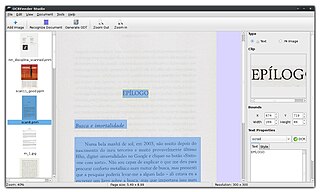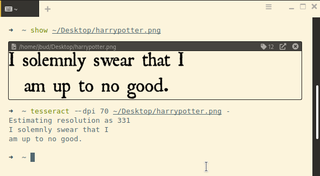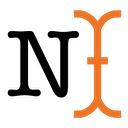 W
WOptical character recognition or optical character reader (OCR) is the electronic or mechanical conversion of images of typed, handwritten or printed text into machine-encoded text, whether from a scanned document, a photo of a document, a scene-photo or from subtitle text superimposed on an image.
 W
WOCRFeeder is an optical character recognition suite for GNOME, which also supports virtually any command-line OCR engine, such as CuneiForm, GOCR, Ocrad and Tesseract. It converts paper documents to digital document files and can serve to make them accessible to visually impaired users.
 W
WOCRopus is a free document analysis and optical character recognition (OCR) system released under the Apache License v2.0 with a very modular design using command-line interfaces.
 W
WTesseract is an optical character recognition engine for various operating systems. It is free software, released under the Apache License. Originally developed by Hewlett-Packard as proprietary software in the 1980s, it was released as open source in 2005 and development has been sponsored by Google since 2006.
 W
WAutomatic number-plate recognition is a technology that uses optical character recognition on images to read vehicle registration plates to create vehicle location data. It can use existing closed-circuit television, road-rule enforcement cameras, or cameras specifically designed for the task. ANPR is used by police forces around the world for law enforcement purposes, including to check if a vehicle is registered or licensed. It is also used for electronic toll collection on pay-per-use roads and as a method of cataloguing the movements of traffic, for example by highways agencies.
 W
WA human-readable medium or human-readable format is any encoding of data or information that can be naturally read by humans.
 W
WIn communications and computing a machine-readable medium, or computer-readable medium, is a medium capable of storing data in a format readable by a mechanical device.
 W
WOCR-A is a font created in 1968, in the early days of computer optical character recognition, when there was a need for a font that could be recognized not only by the computers of that day, but also by humans. OCR-A uses simple, thick strokes to form recognizable characters. The font is monospaced (fixed-width), with the printer required to place glyphs 0.254 cm apart, and the reader required to accept any spacing between 0.2286 cm and 0.4572 cm.
 W
WOCR-B is a monospace font developed in 1968 by Adrian Frutiger for Monotype by following the European Computer Manufacturer's Association standard. Its function was to facilitate the optical character recognition operations by specific electronic devices, originally for financial and bank-oriented uses. It was accepted as the world standard in 1973. It follows the ISO 1073-2:1976 (E) standard, refined in 1979. It includes all ASCII symbols, and other symbols needed in the bank environment. It is widely used for the human readable digits in UPC/EAN barcodes. It is also used for machine-readable passports. It shares that purpose with OCR-A, but it is easier for the human eye and brain to read and it has a less technical look than OCR-A.
 W
WOptical braille recognition is technology to capture and process images of braille characters into natural language characters. It is used to convert braille documents for people who cannot read them into text, and for preservation and reproduction of the documents.
 W
WProject Naptha is a browser extension software for Google Chrome that allows users to highlight, copy, edit and translate text from within images. It was created by developer Kevin Kwok, and released in April 2014 as a Chrome add-on. This software was first made available only on Google Chrome, downloadable from the Chrome Web Store. It was then made available on Mozilla Firefox, downloadable from the Mozilla Firefox add-ons repository but was soon removed. The reason behind the removal remains unknown.
 W
WQANDA is an AI-based learning platform developed by Mathpresso Inc., a South Korea-based education technology company. It uses optical character recognition technology to scan math problems and provide step-by-step solutions.
 W
WreCAPTCHA is a CAPTCHA system that enables web hosts to distinguish between human and automated access to websites. The original version asked users to decipher hard to read text or match images. Version 2 also asked users to decipher text or match images if the analysis of cookies and canvas rendering suggested the page was being downloaded automatically. Since version 3, reCAPTCHA will never interrupt users and is intended to run automatically when users load pages or click buttons. reCAPTCHA is owned by Google.